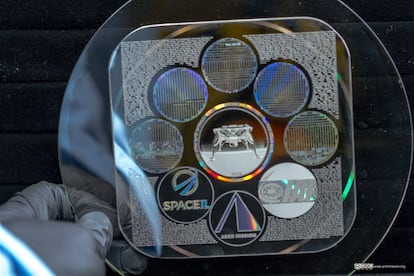An eternal lunar library for aliens to discover
Various initiatives to preserve human history and civilization sent archives into space for extraterrestrial archaeologists to find

On April 11, 2019, the Beresheet lunar lander crashed on the Moon’s Mare Serenitatis plain. It was a privately built space probe that wanted to follow in the footsteps of the United States, Russia and China, but luck was not on its side that day. A gyroscope failure caused software malfunctions, causing the engine to shut off 10 kilometers (6.2 miles) above the Moon’s surface. Although it managed to restart, the Beresheet ultimately crashed on the Moon at a speed of approximately 700 kilometers per hour (435 mph).
The scientific load of this lunar landing engineering test was minimal, with just a few instruments. But the Beresheet also carried a DVD-like disc with a collection of documents, including the Torah, the history of Israel, the country’s declaration of independence, and an English version of Wikipedia. The disc was created by the Arch Mission Foundation, a nonprofit that archives humanity’s heritage for future generations. Its goal is to place multiple redundant repositories of human knowledge around the Solar System, including on Earth. Similar to Carl Sagan’s Pioneer plaques and the Voyager discs, but on a grander scale.
The Beresheet experiment was not the Arch Mission Foundation’s first initiative. In 2018, they launched a copy of Wikipedia into Earth orbit on a nanosatellite aboard a Chinese rocket. They also digitized Isaac Asimov’s Foundation trilogy and persuaded SpaceX to include it in the payload of the first Falcon Heavy rocket. As a clever publicity stunt, Elon Musk’s very own red convertible Tesla was chosen for this task. The Tesla’s screen displayed the phrase “Don’t panic,” a subtle nod to Douglas Adams’s cult classic, The Hitchhiker’s Guide to the Galaxy. The Asimov disc was stored in the glove compartment.
New miniaturization technology
The Arch Lunar Library disc represents the first in a series of lunar archives designed to preserve the records of human civilization for up to billions of years. The Arch Mission Foundation says it’s the only way to ensure the survival of this body of knowledge. Since the disc was being sent to the Moon, it had to adhere to strict size and weight parameters. The Foundation chose a DVD disc-like design, made not of plastic, but of 25 layers of pure nickel, each only 40 microns thick. These layers create a compact package that can be separated if needed. The disc only weighs about 100 grams (3.53 ounces), yet it holds a massive compilation of 30 million pages of text, photo, audio, video and binary data files.
The main challenge was not ensuring the disc’s long-term preservation, but rather finding a way to store the information in a manner that can be accessed by future beings who we may never know. Digitizing the information is not a viable solution, as those of us who still own floppy discs and old cassette tapes well know. Why? There’s hardly any hardware or software left to decipher these relics.
Analog vs. Digital
The Arch Mission Foundation decided to use an analog technique called... photography. Any intelligent being with vision similar to ours should be able to read and interpret them, as long as their technological level was similar or higher. The Lunar Library was not intended for beings who have not reached that stage of technological development, nor for extraterrestrials who communicate through other senses.
The disc cover and its next three layers contain photographic reproductions of 60,000 pages. These can be read using a basic 100x microscope, a technology that any moderately advanced civilization should have (on Earth, we’ve had it for over four centuries). These four layers contain detailed instructions on accessing the rest of the information, which is digitized as a DVD. It consists of 100 compressed gigabytes, equivalent to about 30 million pages of text, audio, video and binary data files. The content is diverse, ranging from global literary works to explanations of David Copperfield’s tricks and ancient Vedic religious texts. The disc was protected by a rigid envelope and placed inside the Beresheet to keep it reasonably safe from the ravages of time, even if the landing was a little rougher than expected.
Throughout history, civilizations have left messages for future generations, with varying levels of success. Egyptian reliefs and Roman inscriptions can still be deciphered after millennia, while medieval manuscripts have endured for centuries. However, delicate paper tends to last only a few hundred years.
Very long-term conservation
Much of the vast amount of digital information produced in recent times is even more fragile than paper because it’s stored on plastic media, which typically lasts only a few decades. Have you ever had a computer mouse that suddenly got sticky? It’s likely due to depolymerization of the mouse’s plastic casing.
Accessing digital information requires specific equipment. A tablet with cuneiform characters, a medieval manuscript and a Baroque painting can be immediately grasped just by looking at them (and knowing the language, of course). However, accessing a PDF document is not quite as easy.
Microfiche is a commonly used medium for long-term storage. It utilizes photographic technology and provides a moderate level of information density — about one page per square centimeter. Theoretically, microfiche can last several centuries when kept in a controlled environment. But ensuring their preservation beyond 50 to 100 years can be challenging.
The manufacturing techniques used for the Lunar Library disc provide significantly increased storage capacity and durability. Nickel, being stable and resistant to oxidation, maintains its integrity for millions of years without radioactive degradation. This is why it was chosen to preserve our knowledge as a legacy for future generations. Or beings from other planets.
Once the entire body of knowledge has been compiled, the next challenge is to find a secure yet accessible storage location. Options include burying copies in abandoned mines, underwater or deep underground, in hopes that future geological changes will resurface them. However, these options may not prevent the library from getting swallowed by the Earth’s mantle. A simpler storage location is space, perhaps anchored in one of the Lagrange points or on the Moon (like the monolith in the sci-fi film, 2001: A Space Odyssey). That was the location selected for the Lunar Library aboard the Beresheet.
The next task is to ensure that future beings can effectively discover, identify and use the contents of the Lunar Library. The disc contains a type of Rosetta stone, featuring a visual dictionary of 7,000 languages with multiple alphabets and rules to aid in interpreting the texts. However, teaching English to someone from the future is not an easy task, and it may even be impossible. A pre-technological society that finds the Lunar Library could inadvertently destroy it. While nickel discs are highly durable, they can still be scratched or smashed by heavy objects. The Arch Mission Foundation believes that the disc’s metallic and iridescent circles, adorned with symbols indecipherable to the naked eye, could transform them into revered objects, protecting them against unintentional and deliberate vandalism.
Perhaps the best defense is to distribute the library widely. Leave copies in various locations, some obvious and easy to find, others hidden and inaccessible. However, there are no guarantees that a copy will be discovered, or that the discoverer will be human or post-human. The Foundation humorously suggests that the worst-case scenario would occur if a telepathic, nickel-eating, cephalopod alien discovers and consumes the tasty disc dessert.
A controversial biological payload
All these plans were ruined when the Beresheet probe crashed into the Moon at high speed. The energy released was equal to almost 66 pounds of TNT explosive. No one is sure whether the Lunar Library survived intact or in pieces. However, the Foundation says that the analog pages would still be readable in each fragment. That’s why they believe the Israeli rocket that carried the Beresheet either put the first universal library or the first archaeological ruin on the Moon.
Another controversial issue revolves around a last-minute addition to the lunar probe — a sample of human tissue and a small colony of tardigrades encased in resin. These minuscule creatures are known for their remarkable resistance to extreme conditions. By hibernating, they can survive in extremely low liquid nitrogen temperatures, boiling water, the vacuum of space and completely desiccated environments.
The Foundation intended to keep these biological specimens inside the probe, next to the disc. However, they may have been ejected during the crash landing and could be on the floor of Mare Serenitatis, waiting for better weather to emerge from hibernation. While most experts believe it’s highly unlikely the tardigrades can survive the Sun’s continuous ultraviolet radiation, doubts persist. Millions of years from now, it’s possible that extraterrestrial archaeologists will stumble upon and categorize these artifacts as authentic remnants of the long-extinct human civilization.
Sign up for our weekly newsletter to get more English-language news coverage from EL PAÍS USA Edition
Tu suscripción se está usando en otro dispositivo
¿Quieres añadir otro usuario a tu suscripción?
Si continúas leyendo en este dispositivo, no se podrá leer en el otro.
FlechaTu suscripción se está usando en otro dispositivo y solo puedes acceder a EL PAÍS desde un dispositivo a la vez.
Si quieres compartir tu cuenta, cambia tu suscripción a la modalidad Premium, así podrás añadir otro usuario. Cada uno accederá con su propia cuenta de email, lo que os permitirá personalizar vuestra experiencia en EL PAÍS.
¿Tienes una suscripción de empresa? Accede aquí para contratar más cuentas.
En el caso de no saber quién está usando tu cuenta, te recomendamos cambiar tu contraseña aquí.
Si decides continuar compartiendo tu cuenta, este mensaje se mostrará en tu dispositivo y en el de la otra persona que está usando tu cuenta de forma indefinida, afectando a tu experiencia de lectura. Puedes consultar aquí los términos y condiciones de la suscripción digital.











































